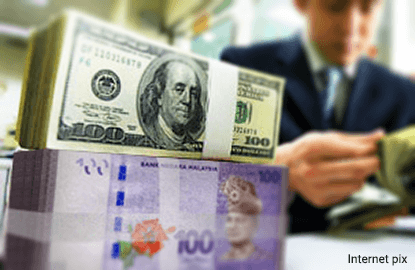
THE ringgit’s precipitous slide against the US dollar and most major currencies, especially in the past fortnight, has sparked renewed concerns over the state of the country’s economy. Having fallen 19% to 4.17 against the greenback since the start of the year, the ringgit is the fastest and steepest falling currency among its regional peers.
While the depreciating currency bodes ill for the man in the street, some opine that the weak ringgit will augur well for the tourism industry as the country becomes a cheaper destination for foreign tourists.

Tourism and Culture Minister Datuk Seri Mohamed Nazri Abdul Aziz told reporters that the weak ringgit will not only lure more foreign tourists but also nudge more Malaysians to spend their holidays in the country.
Yet official statistics show that Malaysia’s tourist arrivals and receipts have been growing steadily the past 16 years, even when the ringgit was strong. The only year when tourist arrivals and receipts saw a year-on-year decline was in 2003 during the outbreak of the severe acute respiratory syndrome (SARS), when travel in the region understandably plummeted. For Malaysia, tourist arrivals contracted 20% to 10.58 million while receipts declined 17.4% to RM21.3 billion.
Meanwhile, when the currency was hovering around the RM4 level against the US dollar in 1998, travel receipts registered in the services account increased 12.4% y-o-y to RM11.8 billion. It is noteworthy that this was the same year the Commonwealth Games was held in Kuala Lumpur and also the year when the government imposed capital controls on the country.
However, based on first-quarter numbers released by Tourism Malaysia for this year, the outlook for the industry does not look promising. Data shows tourist arrivals falling 8.6% y-o-y to 6.48 million in 1Q2015.
There was a pronounced 27% y-o-y decline in Chinese tourist arrivals during the quarter, despite the government’s waiver of visa fees in 2015 for tourists from the country. The lukewarm receipts are perhaps a reflection of the blow to confidence from the twin air tragedies involving the national air carrier last year. Many on board MH370 were Chinese nationals, which is the third largest group of tourists to Malaysia after Singaporeans and Indonesians.
“The Chinese tourists are starting to come back again. But every other country is also trying to attract them. For example, South Korea — to recover from the MERS (Middle East respiratory syndrome) epidemic — is offering huge discounts to the Chinese as well,” says Malaysian Association of Tour & Travel Agents (Matta) president Hamzah Rahmat.
Chinese tourists do not need a visa to visit South Korea’s Jeju Island, for example.
The importance of the tourism industry’s contribution to Malaysia’s economy and foreign exchange earnings is reflected in the sector’s selection as one of the 12 National Key Economic Areas in the country’s Economic Transformation Programme.
Budget 2015 had forecast 29.4 million tourist arrivals and income from foreign tourists totalling RM89 billion.
But Hamzah opines that it is highly unlikely that the targets will be achieved this year.
According to him, the business of travel and tour agencies in the country has seen a 30% decline for both outbound and inbound tourism over the last six to nine months. While the decline could well stem from a softer global economy, chances are the uncertainties in the local economy are not helping.
That said, economists and tourism industry experts see the weak ringgit spurring tourism activities, but the effect will not be seen overnight.
“The currency depreciation doesn’t mean that we will see a lot of foreign tourists at the immigration counters the next day. The effect will not be immediate … it will take time,” Hamzah concurs.
Be that as it may, recent news reports highlight that Malaysia could already be seeing some benefits from the cheap ringgit — those across the causeway are flocking to the country for retail bargains and cheap food.
Year to date, the ringgit has depreciated 11.87% to 2.9619 against the Singapore dollar on Aug 21, a tad firmer from the new all-time low of 2.9736 intraday.
Meanwhile, Malaysia Airports Holdings Bhd revealed that passenger traffic at its airports, excluding its Istanbul airport, only saw a growth of 1.7% for the first seven months of this year compared with the previous year. International traffic contracted 0.6% y-o-y during the same period while domestic traffic grew 3.9% y-o-y.
Some opine that the recent bombings in Thailand could affect travel sentiment, similar to the Bali bombings in 2002 that killed about 200 people, mainly foreign tourists. “Many tour packages cover Singapore, Malaysia and Thailand. So usually, when one country is affected, the rest will feel the impact too,” says an economist. Shortly after the bombings, it was reported that 23 countries issued travel warnings for Thailand.
Matta’s Hamzah believes there will be no spillover effect from this recent tragedy as Thailand has good crisis management skills. Tourism contributes 7%, or US$16 billion, to the country’s gross domestic product, according to the Tourism Authority of Thailand.
As for Malaysia, travel and tourism activities contributed 5.6% or RM61 billion to the country’s GDP last year, says World Travel and Tourism Council in a report. It projects that the industry will contribute 5.8% to GDP in 2025, or some RM95.5 billion.
Malaysia’s GDP grew a surprising 4.9% in the second quarter, putting growth at 5.25% in the first half of 2015 — near the top range of the official forecast of 4.5% to 5.5% growth for this year. It is also still within the 4% to 6% growth that the central bank deems as a “steady growth path”.
With commodity prices staying soft and Brent crude oil prices falling again to hover at US$46 levels, economists say a stronger-than-expected showing by the tourism sector could be what Malaysia needs to meet its targeted GDP growth. Only time will tell if the ringgit’s strength, or weakness, will tip the scales in the country’s favour.
This article first appeared in digitaledgeWeekly, on August 24 - 30, 2015.